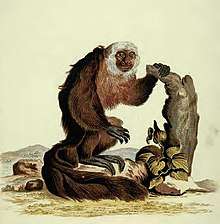Equatorial saki
The equatorial saki (Pithecia aequatorialis), also called the red-bearded saki, is a species of saki monkey, a type of New World monkey. It is found in northeastern Peru and Ecuador.[3]
| Equatorial saki[1] | |
|---|---|
 | |
| Scientific classification | |
| Kingdom: | Animalia |
| Phylum: | Chordata |
| Class: | Mammalia |
| Order: | Primates |
| Suborder: | Haplorhini |
| Infraorder: | Simiiformes |
| Family: | Pitheciidae |
| Genus: | Pithecia |
| Species: | P. aequatorialis |
| Binomial name | |
| Pithecia aequatorialis Hershkovitz, 1987 | |
Not much is known about the equatorial saki, its range being specifically unknown.[4]
Description
The equatorial saki weighs between 2 - 2.5 kg, has a head-body length of 39 – 44 cm, and a tail length of 45 – 47 cm. The species' tail in not prehensile, relying on its arm and leg strength to carry itself from branch to branch.[5] The equatorial saki is also sexually dimorphic. It is often confused for the monk saki, but the reddish throat and chest of the equatorial saki set it apart.[6]
Ecology
The equatorial saki is diurnal. The species is frugivorous, but seeds and nuts constitute a large part of diet. This species also consumes leaves and insects, especially ants. The fruits that this species consumes have hard pericarps.[7] Most of its time is spent foraging in the middle to upper levels of the rainforest canopy.[6]
They seem to be found most commonly in riverside, seasonally flooded and swamp forests, but have been seen in terra firme forests as well.[6]
The red-bearded saki moves through the forest both quadrupedally and by leaping. When the red-bearded saki takes off from a tree branch, most likely it does this from a vertical clinging position.[7]
The equatorial saki lives in small groups of two to four that come together to form larger congregations. Groups of red-bearded sakis are described as closed social units. Males groom their young.[7]
References
![]()
- Groves, C. P. (2005). "Order Primates". In Wilson, D. E.; Reeder, D. M (eds.). Mammal Species of the World: A Taxonomic and Geographic Reference (3rd ed.). Johns Hopkins University Press. p. 147. ISBN 978-0-8018-8221-0. OCLC 62265494.
- Marsh, L.K. & Veiga, L.M. (2008). "Pithecia aequatorialis". IUCN Red List of Threatened Species. 2008: e.T17402A7013094. doi:10.2305/IUCN.UK.2008.RLTS.T17402A7013094.en.
- Marsh, L. K. (July 2014). "A Taxonomic Revision of the Saki Monkeys, Pithecia Desmarest, 1804". Neotropical Primates. 21 (1): 1–165. doi:10.1896/044.021.0101.
- "Equatorial Saki - Pithecia aequatorialis - Overview - Encyclopedia of Life". Encyclopedia of Life. Retrieved 2017-03-15.
- "Saki Ecuatorial (In Spanish)". Damsiela.com.
- "Equatorial Saki Monkey". Project Noah. Retrieved 2017-03-15.
- Flannery, Sean. "Red-bearded Saki (Pithecia aequatorialis)". www.theprimata.com. Retrieved 2017-03-15.
